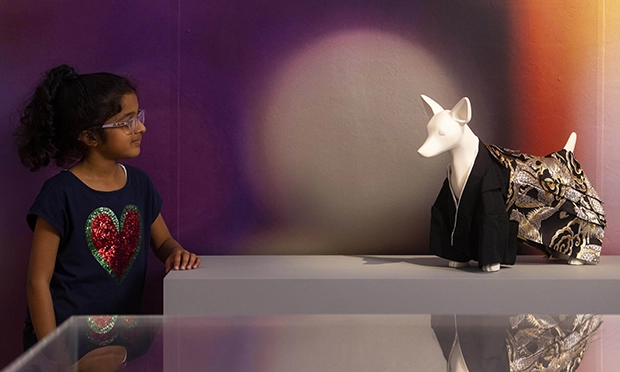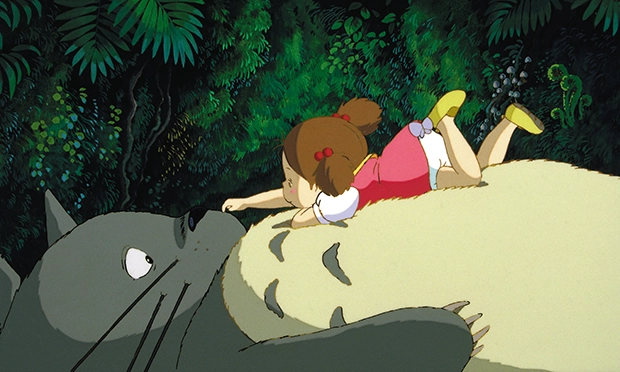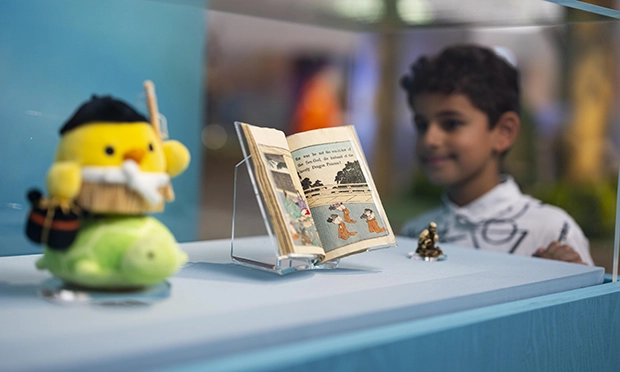Japan: Myths to Manga, Young V&A, exhibition review: ‘A rich experience that will get both children and adults talking’

A child visits the exhibition. Photograph: David Parry / courtesy V&A
“Japan is bursting with imagination and inventiveness,” reads a caption inside the newly opened Young V&A’s first major exhibition.
The statement is evident from the large round rug you have to walk over to read it.
It’s a map of Japan, illustrated by hugely expressive emoticons that look like cartoons (really, look up Japanese emoticons. They are amazing).
Clouds and trees with smiley faces, and animals that will feel familiar to anyone who has grown up playing a Mario game.
Let’s start at the beginning.
Japan: Myths to Manga is not, as you might expect, an exhibition about how Japanese culture started with myths and arrived at mangas. Nor is it about the impact of myths on mangas.
It does, however, manage to explore both ideas, and more besides.

A still from My Neighbour Totoro. Image: Studio Ghibli, 1988
The exhibition was originally conceived in 2020 during Covid restrictions, with the idea being that it would take visitors on a journey through Japan.
As someone who has been interested in Japanese culture in some form or another since a young age, one big question intrigued me: how will the museum bring Japan to Bethnal Green?
This is achieved by dividing the displays into four categories: sky, forest, cities and sea. It’s concise, yet strangely complete.
The four sections feel plucked from time rather than invented for convenience.
This allows a Hinamatsuri (Girl’s Day) miniature furniture set from about 1870 to sit opposite a Sylvanian Families set from 1987-95 and still feel natural.
You’ll be looking at Hokusai or Kunisada prints one moment, and Sailor Moon animation cels (in diminishing states of completion, to reveal how they are made) in another, or even watching Studio Ghibli’s Ponyo.
You’ll also find anime and manga objects. The list of these is not designed to be hugely comprehensive. It features Pokemon, Yokai Watch, and a variety of Studio Ghibli animations, including the stage model from the Royal Shakespeare Company’s production of My Neighbour Totoro.

‘A rich, mixed-media experience.’ Photograph: David Parry / courtesy V&A
The exhibition is far more interested in showcasing the inspirations behind some of these objects.
Naruto fans may be familiar with the names Kaguya and Amaterasu, for example. Both are famous tales from Japanese mythology that the manga’s creators incorporated.
The exhibition could have been named Japan: Play, Design, Imagine after the usual sections of the museum.
This may be your first time back since the museum’s relaunch as the Young V&A. It was formerly the Museum of Childhood.
There is a clear pivot away from its Victorian past as a repository about the social history of childhood. It’s now a much brighter, hands-on, engaging place, with the needs of children of all ages at the forefront.
Katy Canales, curator of Japan: Myths to Manga, said: “The same playfulness that fuels Japan’s creativity sits at the heart of Young V&A.
“For the exhibition, we’ve brought together the V&A’s incredible collections alongside amazing loans to explore the influence of Japan’s fascinating folktales to their fullest.”
And a lot of thought went into the show.
Canales added: “We had incredible debates over every word. We had a huge debate about the word ‘tectonic’.”
What emerges is a rich, mixed-media experience that will get both children and adults talking.
